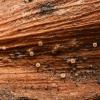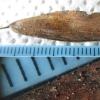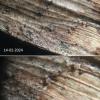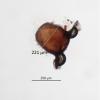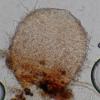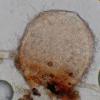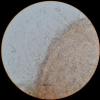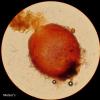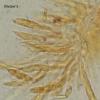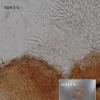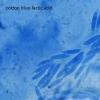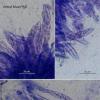
16-02-2024 20:14
 Riet van Oosten
Riet van Oosten
Hello, Found by Laurens van der Linde Febr. 2024

16-02-2024 18:12
Margot en Geert VullingsThis ascomycete was found on deer droppings. One

16-02-2024 11:39
 Marc Detollenaere
Marc Detollenaere
Dear Forum,On Epilobium I found some small black a

12-02-2024 23:41
 Edvin Johannesen
Edvin Johannesen
These very tiny apothecia were growing on capsules

14-02-2024 10:47
Me mandan el material seco de Galicia (España) re

19-03-2022 19:55
 Robin Isaksson
Robin Isaksson
Found on fallen twigs I cant find notes on Spore
Hydropisphaera? on fruits of Fraxinus
Riet van Oosten,
16-02-2024 20:14

Hello,
Found by Laurens van der Linde Febr. 2024 on fruits of Fraxinus.
Ascomata < 250 µm
KOH -
Asci J -
Spores 1-septate, smooth Me: 20.3 x 4.6 µm N = 4
Greetings, Riet
Alain GARDIENNET,
17-02-2024 09:15
Re : Hydropisphaera? on fruits of Fraxinus
Hi Riet,
Did you think at Ijuhya genus ?
Alain
Did you think at Ijuhya genus ?
Alain
Riet van Oosten,
17-02-2024 10:14

Re : Hydropisphaera? on fruits of Fraxinus
Hi Alain,
Yes, I used the key to the genera allied to Ijuhya (pdf AscomyceteOrg 11-02 55-64) on page 63
and with "2. Hairs arising from cells of ascomatal wall, evenly covering ascomatal surface, solitary or fasciculate; ascospores smooth or striate" I arrive at Lasionectria.
Then I used the key Lasionectria on page 279 (Lechat, C. & J. Fournier (2012) A new species of Lasionectria, L. martinicencis. Mycotaxon 121: 275-280), but no match
Brigitte Bloem,
17-02-2024 12:30

Re : Hydropisphaera? on fruits of Fraxinus
hello Riet,
Another person in the Netherlands found this asco and posted it at the Facebooksite of the NMV (mycological organisation). Probably it's an anamorfic: Phomopsis pterphila (there're two types, small on te wings of the seeds, Phoma samararum, and bigger on the seeds itself, Phoma samararum, accourding to this text https://www.paddenstoelenwerkgroep-noordenveld.nl/waarnemingen/anamorfe-ascomyceten?fbclid=IwAR2onhq6MXF2r4GJt3ZbAoqBLvsosLYdrxU4noJzs_mEuW_oH_GuU1X3lco.
d
Best regards,
Briigtte
Another person in the Netherlands found this asco and posted it at the Facebooksite of the NMV (mycological organisation). Probably it's an anamorfic: Phomopsis pterphila (there're two types, small on te wings of the seeds, Phoma samararum, and bigger on the seeds itself, Phoma samararum, accourding to this text https://www.paddenstoelenwerkgroep-noordenveld.nl/waarnemingen/anamorfe-ascomyceten?fbclid=IwAR2onhq6MXF2r4GJt3ZbAoqBLvsosLYdrxU4noJzs_mEuW_oH_GuU1X3lco.
d
Best regards,
Briigtte
Brigitte Bloem,
17-02-2024 12:32

Re : Hydropisphaera? on fruits of Fraxinus
Riet van Oosten,
17-02-2024 12:53

Re : Hydropisphaera? on fruits of Fraxinus
Hello Brigitte,
Thank you for your reaction!
The ascocarps in this topic are teleomorphs
Thank you for your reaction!
The ascocarps in this topic are teleomorphs
Alain GARDIENNET,
18-02-2024 09:15
Re : Hydropisphaera? on fruits of Fraxinus
Hi Riet,
It's not easy to sort through all this complex in Bionectriaceae. Christian told me that hair insertion was an important first step to observe, as you read in the key. But you still need to make a sufficiently precise cut, as he was so good at doing. A median vertical section is expected for that.
It's with such collection that we can see that he leaves us a great void. But you're right to post this find. Let's hope that a specialist mycologist takes up the topic.
Best wishes,
Alain
It's not easy to sort through all this complex in Bionectriaceae. Christian told me that hair insertion was an important first step to observe, as you read in the key. But you still need to make a sufficiently precise cut, as he was so good at doing. A median vertical section is expected for that.
It's with such collection that we can see that he leaves us a great void. But you're right to post this find. Let's hope that a specialist mycologist takes up the topic.
Best wishes,
Alain
Riet van Oosten,
18-02-2024 09:25

Re : Hydropisphaera? on fruits of Fraxinus
Thank you for your help and the information Alain!
I tried to get a median vertical section but until now without success.
Best wishes, Riet
I tried to get a median vertical section but until now without success.
Best wishes, Riet


